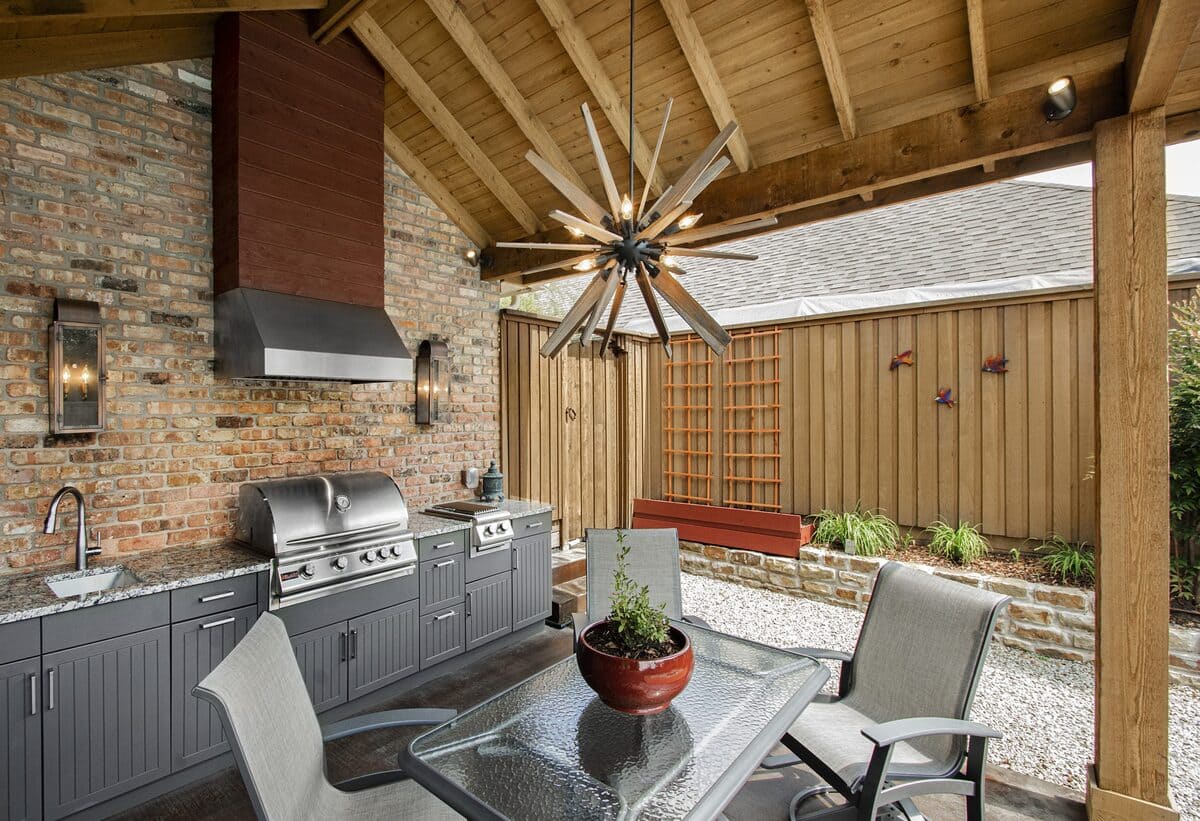Introduction
Outdoor kitchens are becoming an increasingly popular feature in homes, offering a perfect blend of functionality and entertainment space. Whether you’re looking to enhance your backyard for hosting gatherings or simply enjoy cooking in the fresh air, understanding the latest designs and trends can help you create an outdoor kitchen that is both stylish and practical. This article will explore various outdoor kitchen designs, current trends, and practical tips to help you make the most of your outdoor cooking space.
Introduction to Outdoor Kitchens
Benefits of Having an Outdoor Kitchen
Outdoor kitchens Gulf Coast extend your living space, providing a unique area for cooking, dining, and entertaining guests. They can transform a basic backyard into a functional and inviting environment. Benefits include:
- Entertainment: Hosting events outdoors becomes more enjoyable with a fully-equipped kitchen.
- Convenience: Outdoor kitchens keep cooking smells and mess outside, reducing indoor clutter.
- Increased Home Value: A well-designed outdoor kitchen can significantly boost your home’s resale value.
- Healthier Living: Cooking outside encourages healthier eating habits, as grilling is often a healthier option compared to frying.
Key Considerations Before Designing an Outdoor Kitchen
Before diving into the design process, consider the following factors:
- Space and Layout: Assess the available space and decide on the kitchen’s layout. Common layouts include L-shaped, U-shaped, and linear designs.
- Budget: Determine a budget for your project, considering costs for materials, appliances, and labor.
- Functionality: Identify your cooking needs and preferences. Do you need a full kitchen with a grill, sink, and fridge, or just a simple grilling station?
- Climate: Consider your local climate. Ensure your kitchen can withstand weather conditions and think about incorporating features like pergolas or awnings for shade and protection.
Popular Outdoor Kitchen Designs
Traditional Outdoor Kitchens
Traditional outdoor kitchens often feature classic materials such as brick, stone, and wood. These designs create a timeless look that complements many home styles. Key elements include:
- Brick Ovens: Ideal for baking pizzas and bread, adding a rustic charm.
- Wood-Fired Grills: Enhance the flavor of grilled foods, offering a more authentic cooking experience.
- Natural Stone Countertops: Durable and weather-resistant, providing a natural aesthetic.
Modern and Minimalist Outdoor Kitchens
Modern designs focus on clean lines, simplicity, and functionality. They often use sleek materials like stainless steel, concrete, and glass. Features include:
- Integrated Appliances: Seamless integration of grills, refrigerators, and sinks into cabinetry.
- Minimalist Furniture: Simple, functional seating and dining areas that don’t overcrowd the space.
- Neutral Color Palettes: Shades of gray, white, and black dominate, creating a sophisticated look.
Rustic and Natural Designs
Rustic outdoor kitchens embrace natural materials and a cozy, welcoming atmosphere. Common elements are:
- Reclaimed Wood: Used for cabinetry and countertops, adding warmth and character.
- Stone Fireplaces: Provide a focal point and a source of warmth during cooler evenings.
- Wrought Iron Accents: Durable and decorative, enhancing the rustic charm.
Current Trends in Outdoor Kitchens
Sustainable and Eco-Friendly Materials
There is a growing trend toward using sustainable and eco-friendly materials in outdoor kitchen design. Options include:
- Recycled Countertops: Made from recycled glass, concrete, or paper.
- Bamboo Cabinetry: A renewable resource that is both durable and stylish.
- Low-VOC Paints: Used for cabinetry and furniture, reducing harmful emissions.
Integrated Technology
Modern outdoor kitchens increasingly incorporate technology for convenience and entertainment. Features include:
- Smart Appliances: Grills with Wi-Fi connectivity and remote control capabilities.
- Outdoor Lighting: LED lights with smart controls for ambiance and functionality.
- Sound Systems: Integrated speakers and audio systems for music and entertainment.
Multifunctional Spaces
Outdoor kitchens are evolving into multifunctional spaces that go beyond cooking. They often include:
- Seating and Dining Areas: Comfortable seating arrangements for family and guests.
- Entertainment Zones: Areas for TVs, fire pits, and even outdoor movie screens.
- Gardening Spaces: Incorporating herb gardens or planters for fresh ingredients.
Essential Features and Components
Grills and Cooking Appliances
The grill is the centerpiece of any outdoor kitchen. Types of grills include:
- Gas Grills: Easy to use and quick to heat up, offering precise temperature control.
- Charcoal Grills: Provide a smoky flavor, ideal for traditional grilling enthusiasts.
- Electric Grills: Suitable for small spaces or areas with restrictions on open flames.
- Wood-Fired Grills: Add a distinct flavor to food, perfect for gourmet cooking.
Storage Solutions
Adequate storage is crucial for keeping your outdoor kitchen organized and functional. Options include:
- Cabinetry: Custom cabinets made from weather-resistant materials like stainless steel or marine-grade polymer.
- Shelving: Open shelves for easy access to frequently used items.
- Built-In Storage: Integrated into countertops or under seating areas to maximize space.
Countertops and Workspaces
Countertops should be durable, weather-resistant, and easy to clean. Popular materials are:
- Granite: Extremely durable and available in a variety of colors and patterns.
- Concrete: Can be customized with colors and textures, offering a modern look.
- Tile: Resistant to heat and available in numerous styles, though grout lines require maintenance.
Outdoor Sinks and Refrigeration
An outdoor sink and refrigerator enhance the functionality of your kitchen. Consider:
- Stainless Steel Sinks: Durable and easy to clean, suitable for outdoor use.
- Portable Refrigerators: Can be moved as needed, ideal for smaller kitchens.
- Built-In Refrigerators: Provide ample storage for food and beverages, integrating seamlessly into cabinetry.
Tips for Planning and Designing Your Outdoor Kitchen
Budgeting and Planning
- Set a Realistic Budget: Consider costs for design, materials, appliances, and labor. Allocate extra funds for unexpected expenses.
- Plan the Layout: Ensure efficient workflow by placing appliances and workspaces in a logical order (e.g., grill, prep area, sink, serving area).
- Hire Professionals: Consult with designers, contractors, and landscapers to ensure a cohesive and functional design.
Choosing the Right Materials
- Durability: Select materials that can withstand outdoor conditions, such as stainless steel, natural stone, and weather-resistant wood.
- Maintenance: Opt for low-maintenance materials to reduce upkeep and prolong the life of your kitchen.
- Aesthetics: Choose materials that complement your home’s style and your personal taste.
Maximizing Space and Layout
- Efficient Use of Space: Utilize vertical space with wall-mounted cabinets and shelves. Consider compact appliances if space is limited.
- Zoning: Create distinct zones for cooking, dining, and entertaining to ensure a smooth workflow.
- Flexibility: Incorporate movable furniture and portable appliances to adapt to different needs and occasions.
Incorporating Weather-Resistant Features
- Weatherproofing: Use materials and finishes designed for outdoor use. Ensure proper sealing and waterproofing to prevent damage.
- Shade and Shelter: Install pergolas, awnings, or umbrellas to protect against sun and rain. Consider retractable options for flexibility.
- Heating and Cooling: Include features like outdoor heaters, fans, or misters to extend the usability of your kitchen throughout the year.
Maintenance and Care for Outdoor Kitchens
Regular Cleaning and Upkeep
- Surfaces: Clean countertops, grills, and appliances regularly to prevent buildup of grease and grime.
- Furniture: Use weather-resistant covers or store furniture indoors during harsh weather.
- Floors: Sweep and wash outdoor flooring to remove debris and stains.
Protecting Appliances and Surfaces
- Grill Covers: Use covers to protect grills from weather and dust when not in use.
- Stainless Steel Care: Apply stainless steel cleaner and polish to prevent rust and maintain shine.
- Sealing Countertops: Reseal stone countertops periodically to protect against stains and moisture.
Seasonal Maintenance Tips
- Spring: Inspect and clean all components, check for any winter damage, and restock supplies.
- Summer: Ensure proper ventilation and shading to keep appliances cool. Regularly clean grills and surfaces.
- Fall: Prepare for colder months by deep cleaning and storing or covering furniture and appliances.
- Winter: If not using the kitchen, winterize appliances by disconnecting and draining water lines. Use weatherproof covers for protection.
Conclusion
An outdoor kitchen is a fantastic addition to any home, providing a unique space for cooking, dining, and entertaining. By staying informed about the latest designs and trends, and following practical planning and maintenance tips, you can create an outdoor kitchen that enhances your lifestyle and adds value to your home. Whether you prefer a traditional, modern, or rustic design, the key is to create a functional and beautiful space that suits your needs and complements your outdoor environment. With careful planning and attention to detail, your outdoor kitchen can become a favorite gathering spot for family and friends, offering years of enjoyment and culinary delight.
Read More From Techbullion And Businesnewswire.com



































